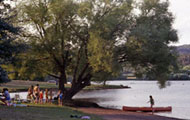- Swimming
- Interview :: Mick Munroe
- Interview :: Andrew Jennings
- Boating
- Interview :: Bob and Carol Lewis
- Interview :: John Southwood
- Object :: Kayaks
- Object :: John Southwood's Kayak
- Object :: Olympics Blazers
- Fishing
- Interview :: Kevin Laughton
- Object :: Brown Trout
- Object :: Fly Lines
- Object :: Fishing Rods
- Object :: Golden Perch
- Object :: OTAS Memorabilia
- Parks, Gardens and Fountains
- Interview :: John Chappell
- Object :: Water Stress Sculpture
Boating
Over the years, people have taken to district waterways for pleasure and competition in all kinds of vessels, from 44-gallon drums to high-tech kayaks. Every opportunity was seized to enjoy the water, from a relaxing afternoon in a dinghy on a local waterway to a sailing competition on one of the larger dams.
Sailing and rowing regattas were held when Gosling Creek Reservoir was opened in 1890. In Lucknow, a boating lake was built at the instigation of Henry Newman, constructed in their spare time by men who worked in the mines. The lake was built to give the miners and their families a means of recreation and they took to the water in a variety of craft. Women also became proficient at boating.
A grand regatta was held on the Boat Dam at Lucknow in 1888 striking curiosity from those that had never seen a boat and others who had never witnessed a regatta.
Boating in the Orange district has remained popular. In the late 1950s, the enthusiasm of Dutch migrant Joe Runeman resulted in many local people taking to canoeing. This led to Orange producing two Olympic canoeists, John Southwood and John Sumegi. John Southwood trained at Lake Canobolas and some of his Olympic rivals found it incredible that he trained on a waterway barely 500 metres long while holding down full-time employment as a carpenter.
In 2004, Orange City Council granted Kinross Wolaroi School permission to undertake rowing training on Spring Creek Reservoir. Local conservationists are monitoring bird populations to ensure the rowing does not interfere with their nesting and food gathering.
Lucknow RegattaThe program embraced fifteen races, pretty evenly distributed between ladies and gentlemen. The entries, including a number from Sydney were very large, as many as forty-one names of competitors being in for the Governor's cup, and had there not been a liberal use of the pen in scratchings it would be hard to surmise when the programme could have been got through. The preparations for the day’s sport were complete. An enclosure extending the full width of the West or winning end of the lake was reserved for ladies, back forms from the Miner's Hall having been brought over for the accommodation of the fair spectators who, while sheltered from the sun’s rays had an uninterrupted view of the whole course. A black board was placed on the left bank, where Mr LC Young recorded the time of each competitor and on the opposite bank was the starter’s, timekeepers’, and judge's box.
The affair passed off smoothly and agreeably from beginning to end. Bunting flying with the breeze at the poppet heads of the mines proclaimed a gala festival; also from a dozen posts around the lake and with streamers across it, while over the ladies' pavilion were the well known colors of Jackass Flat, New Reform, New Reform Pups and others. On the ground were the usual concomitants of a sporting gathering: shooting gallery, swinging boats, merry-go-round, doodle-em-buck, a booth under the charge of Mr Blunt, a refreshment room and minor attributes, while a lofty stand had been erected for the band. Hundreds of packets of tickets had been sent out which would not admit of a refusal, and for days the sale of these had been pushed in a most persistent way, yet five hundred were sold at the gates, and it is estimated that between ten and twelve hundred persons witnessed the regatta.
An extract from the Western Advocate
Wednesday 14 November 1888.
